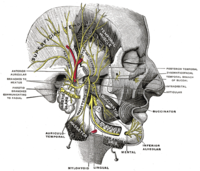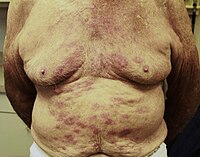
Multi‐organ carcinogenicity by inhalation exposure to 2‐Bromopropane in rats
Sign Up to like & getrecommendations! Published in 2023 at "Journal of Occupational Health"
DOI: 10.1002/1348-9585.12388
Abstract: Abstract Objective The purpose of this study was to investigate the carcinogenicity of 2‐bromopropane (2‐BP) in rats. Methods Male and female F344 rats were exposed by whole body inhalation to 2‐BP vapor at concentrations of… read more here.
Keywords: carcinogenicity; multi organ; gland; inhalation exposure ... See more keywords

Examination of the best head tilt angle to reduce the parotid gland dose maintaining a safe level of lens dose in whole‐brain radiotherapy using the four‐field box technique
Sign Up to like & getrecommendations! Published in 2021 at "Journal of Applied Clinical Medical Physics"
DOI: 10.1002/acm2.13151
Abstract: Abstract The parotid gland is recognized as a major‐risk organ in whole‐brain irradiation; however, the beam delivery from the left and right sides cannot reduce the parotid gland dose. The four‐field box technique using a… read more here.
Keywords: parotid gland; lens dose; reduce parotid; gland dose ... See more keywords

Positional deformation of the parotid gland: Application to minimally invasive procedures
Sign Up to like & getrecommendations! Published in 2022 at "Clinical Anatomy"
DOI: 10.1002/ca.23941
Abstract: Anatomical studies of the parotid gland are important for mid‐ and lower face filler, botulinum toxin, and thread lifting procedures. The purpose of this study was to observe the topographic anatomy of the parotid gland… read more here.
Keywords: parotid gland; reference; positional deformation; gland ... See more keywords

The Milan system for reporting salivary gland cytopathology-A single-center study of 2156 cases.
Sign Up to like & getrecommendations! Published in 2023 at "Cancer medicine"
DOI: 10.1002/cam4.5914
Abstract: BACKGROUND Fine-needle aspiration cytology (FNAC) represents an important diagnostic tool for the workup of salivary gland (SG) lesions. The Milan System for Reporting Salivary Gland Cytopathology (MSRSGC) is a six-tiered system for standardizing diagnoses and… read more here.
Keywords: system reporting; gland; reporting salivary; salivary gland ... See more keywords

Female prostate: historical, developmental, and morphological perspectives
Sign Up to like & getrecommendations! Published in 2017 at "Cell Biology International"
DOI: 10.1002/cbin.10759
Abstract: The female prostate was first described by Reijnier de Graaf in 1672, and even after several years this gland is still a matter of controversy. Part of this is because the biological function of this… read more here.
Keywords: prostate; historical developmental; prostate historical; gland ... See more keywords

Northern Italy in the American South: Assessing interobserver reliability within the Milan System for Reporting Salivary Gland Cytopathology
Sign Up to like & getrecommendations! Published in 2018 at "Cancer Cytopathology"
DOI: 10.1002/cncy.21989
Abstract: The Milan System for Reporting Salivary Gland Cytopathology (MSRSGC) has been proposed to standardize salivary gland fine‐needle aspiration (FNA) diagnoses. This study assessed salivary gland FNA results and risk of malignancy (ROM) rates at the… read more here.
Keywords: system reporting; milan system; salivary gland; reporting salivary ... See more keywords

Subtyping salivary gland neoplasm of uncertain malignant potential based on cell type demonstrates differential risk of malignancy
Sign Up to like & getrecommendations! Published in 2018 at "Cancer Cytopathology"
DOI: 10.1002/cncy.22066
Abstract: The newly unveiled Milan System for Reporting Salivary Gland Cytopathology (MSRSGC) has proposed salivary gland neoplasm of uncertain malignant potential (SUMP) as an indeterminate category. The category is reserved for fine‐needle aspiration (FNA) cases that… read more here.
Keywords: uncertain malignant; salivary gland; gland neoplasm; gland ... See more keywords

Cytologic grading of primary malignant salivary gland tumors: A blinded review by an international panel
Sign Up to like & getrecommendations! Published in 2020 at "Cancer Cytopathology"
DOI: 10.1002/cncy.22271
Abstract: Fine needle aspiration (FNA) is commonly used for the preoperative evaluation of salivary gland tumors. Tumor grade is a key factor influencing clinical management of salivary gland carcinomas (SGCs). To assess the ability to grade… read more here.
Keywords: international panel; gland tumors; salivary gland; review ... See more keywords

Application of the Milan System for Reporting Salivary Gland Cytopathology to cystic salivary gland lesions
Sign Up to like & getrecommendations! Published in 2020 at "Cancer Cytopathology"
DOI: 10.1002/cncy.22363
Abstract: Cystic salivary gland lesions present diagnostic challenges on fine‐needle aspiration (FNA) specimens that are related to sampling limitations and a broad differential diagnosis. This study evaluated the benefit of applying the Milan System for Reporting… read more here.
Keywords: gland lesions; milan system; cystic salivary; salivary gland ... See more keywords

Is Milan for kids?: The Milan System for Reporting Salivary Gland Cytology in pediatric patients at an academic children's hospital with cytologic-histologic correlation.
Sign Up to like & getrecommendations! Published in 2021 at "Cancer cytopathology"
DOI: 10.1002/cncy.22455
Abstract: BACKGROUND The Milan System for Reporting Salivary Gland Cytopathology (MSRSGC) provides a useful framework for the diagnosis of salivary gland fine-needle aspiration (FNA) biopsies. In this study, the MSRSGC was applied to salivary gland FNAs… read more here.
Keywords: salivary gland; cytology; milan system; gland ... See more keywords

Application of the Milan System for Reporting Salivary Gland Cytopathology in pediatric patients: An international, multi‐institutional study
Sign Up to like & getrecommendations! Published in 2022 at "Cancer Cytopathology"
DOI: 10.1002/cncy.22556
Abstract: Pediatric salivary gland fine‐needle aspiration (FNA) is uncommon with a higher frequency of inflammatory lesions and a small proportion of malignancies. This international, multi‐institutional cohort evaluated the application of the Milan System for Reporting Salivary… read more here.
Keywords: cytopathology; international multi; multi institutional; gland ... See more keywords